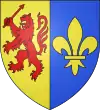Arcangues
Arrangoitze | |
|---|---|
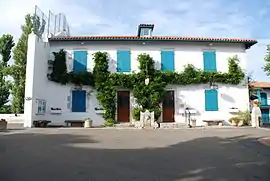 Arcangues Town Hall | |
.svg.png.webp) Coat of arms | |
Location of Arcangues | |
 Arcangues 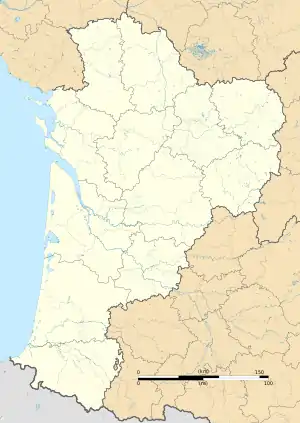 Arcangues | |
| Coordinates: 43°26′15″N 1°31′11″W / 43.4375°N 1.5197°W | |
| Country | France |
| Region | Nouvelle-Aquitaine |
| Department | Pyrénées-Atlantiques |
| Arrondissement | Bayonne |
| Canton | Ustaritz-Vallées de Nive et Nivelle |
| Intercommunality | CA Pays Basque |
| Government | |
| • Mayor (2020–2026) | Philippe Echeverria[1] |
| Area 1 | 17.47 km2 (6.75 sq mi) |
| Population | 3,457 |
| • Density | 200/km2 (510/sq mi) |
| Time zone | UTC+01:00 (CET) |
| • Summer (DST) | UTC+02:00 (CEST) |
| INSEE/Postal code | 64038 /64200 |
| Elevation | 4–140 m (13–459 ft) (avg. 60 m or 200 ft) |
| 1 French Land Register data, which excludes lakes, ponds, glaciers > 1 km2 (0.386 sq mi or 247 acres) and river estuaries. | |
Arcangues (French pronunciation: [aʁkɑ̃g]; Basque: Arrangoitze) is a commune in the Pyrénées-Atlantiques department in the Nouvelle-Aquitaine region of southwestern France in what was formerly the Basque province of Labourd.
Geography
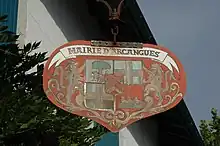
Location
Arcangues belongs to the urban area of Bayonne and is located some 10 km south by south-west of Bayonne, 8 km south-east of Biarritz, and 6 km north-west of Ustaritz.
Access
The A63 autoroute passes through the northern tip of the commune with the nearest exit being Exit ![]() 4 to the west of the commune but the slightly farther Exit
4 to the west of the commune but the slightly farther Exit ![]() 5 to the east connects directly to the D3 road which passes south through the commune and the village to Saint-Pée-sur-Nivelle. There is also the D755 which branches off the D3 in the north of the commune and continues south through the west of the commune to join the D255 on the commune's south-western border. The D933 road from Anglet to Ustaritz also passes through the eastern tip of the commune with a roundabout linking to country roads in the commune.[3]
5 to the east connects directly to the D3 road which passes south through the commune and the village to Saint-Pée-sur-Nivelle. There is also the D755 which branches off the D3 in the north of the commune and continues south through the west of the commune to join the D255 on the commune's south-western border. The D933 road from Anglet to Ustaritz also passes through the eastern tip of the commune with a roundabout linking to country roads in the commune.[3]
Hydrography
The commune of Arcangues is traversed by the river Uhabia,[4] the Urdainzko erreka,[5] and the Harrietako erreka.[6] The latter two discharge into the Nive, a tributary of the Adour.
Places and hamlets
- Ablaintz[7]
- Abots[7]
- Amestoia
- Arantzeta
- Arantzetakoborda
- Arnega
- Berriotz[7]
- Bidauenea
- Borda Chipia
- Bordabaxea
- Bordattoa
- le Bosquet
- Chapelet
- la Chapelle[7]
- le Château
- Chouroumillatché[7]
- Dornarieta[7]
- Ehailenborda
- Errota Handia
- Errotaxipia
- Etchegaraya
- Garaten Borda
- Gastelhur[7]
- Gorriaenea
- Haranburua
- Harretchea
- Hirigoina
- Hotchaenea
- Kalonjaenea
- Kastillaborda
- Lahiton
- Lanchipiette
- Larrebidea
- Larreburua
- Larrechurria
- Logis d'Arbela
- Lortenea
- Marittipienea
- Mendibista
- Moulin d'Alotz[7]
- Othe Xuria
- Othe Zahar[7]
- Oyhambidea
- Planuya
- Sainte-Barbe[7]
- Salazaharia
- Salha
- Teileria
- Xurrumilatx
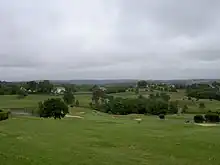
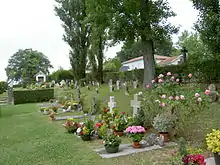
Toponymy
The basque name of the commune is Arrangoitze.[8]
Jean-Baptiste Orpustan[9] proposed a joining of the basque words ar-gain, meaning "high rock", and -goiz meaning "an open position facing east" which results in the compound meaning "high rocks facing east".
The following table details the origins of the commune name and other names in the commune.
| Name | Spelling | Date | Source | Page | Origin | Description |
|---|---|---|---|---|---|---|
| Arcangues | Archangos | 1170 | Orpustan | 31 | Village | |
| Archagos | 1170 | Orpustan | 31 | |||
| Archagos | 12th century | Raymond | 9 | Bayonne | Village | |
| Arcangos | 1249 | Orpustan | 31 | |||
| Arcangos | 1255 | Raymond | 9 | Bayonne | ||
| Archangos | 13th century | Raymond | 9 | |||
| Argangois | 1302 | Raymond | 9 | Chapter | ||
| Argangos | 1302 | Raymond | 9 | Chapter | ||
| Saint-Jean-Baptiste d'Arcangos | 16th century | Raymond | 9 | Collations | ||
| Ablaintz | Ablaintz | 1083 | Goyheneche | |||
| Naubeis | 1149 | Goyheneche | (Naubeys in Gascon | |||
| Abots | Abots | 1863 | Raymond | 2 | Village | |
| Alotz | Alots | 1863 | Raymond | 5 | Stream which gave its name to the Moulin d'Alotz with a source in Arcangues and fed the Uhabia. | |
| Berriotz | Le Bois de Berriots | 13th century | Raymond | 29 | Bayonne | Wood |
| La Chapelle | La Chapelle | 1863 | Raymond | 48 | Hamlet | |
| Chourroumilatch | Chouroumillatché | 1863 | Raymond | 50 | Mill | |
| Dornadieta | Dornariette | 1863 | Raymond | 57 | Hamlet | |
| Gastelhur | Gaztelur | 1401 | Arcangues | 68 | Farm | |
| Gastelur | 1764 | Raymond | 68 | Collations | There was a prebend of its name in the Church of Arcangues | |
| Gastellur | 1863 | Raymond | 68 | |||
| Jauréguia | Jauréguia | 1863 | Raymond | 85 | Farm | |
| Othe Zahar | Othéçarra | 1863 | Raymond | 129 | Wood | |
| Sainte-Barbe | Sainte-Barbe | 1863 | Raymond | 146 | A rise in the land between Arcangues and Ustaritz |
Sources:
- Orpustan: Jean-Baptiste Orpustan, New Basque Toponymy p. 31 (in French)[9]
- Raymond: Topographic Dictionary of the Department of Basses-Pyrenees, 1863, on the page numbers indicated in the table. (in French)[7]
- Goyheneche: Basque Country[10]
- Arcangues: Arcangues, Under the direction of Hubert Lamant-Duhart[11]
Origins:
History
- The lordship of Arcangues
The lordship of Arcangues has been mentioned since the 12th century.[11] Sanche d'Arcangues[12] and Aner de Archangos were cited as witnesses or guarantors of real estate transactions between 1150 and 1170.
- Plague
The beginning of the 16th century in Labourd was marked by the appearance of the plague. The Gascon registers[15] track its expansion. on 8 February 1517 the plague was reported in Arcangues.
- The King's Prosecutors
The office of King's Prosecutor belonged to the Arcangues family from the 17th century. Also Laurent, Lord and patron of Arcangues, Curutcheta, and Elissagaray was prosecutor of the Bailiwick of Labourd from 1614 to 1643.[16] His son Jean d'Arcangues received the office of King's Prosecutor by letters patent of Louis XIII of 4 July 1643. Pierre d'Arcangues continued in the office from 1670 to 1692. Finally Squire Gaspard d'Arcangues, Lord and patron of Arcangues and Curutcheta was the last family member to hold the office from 15 April 1714 to 1749.
- The Marquis of Iranda[11]
Squire Michel d'Arcangues, Lord and patron of Arcangues and Curutcheta, baptised at Bayonne on 17 October 1719, captain of the provincial militia of Labourd, married to Rose d'Aragorri (1722-1758), by which the title of Spanish Marquis of Iranda[17] passed to their son Nicolas François Xavier d'Arcangues (Arcangues, 1753 - Saint-Pierre-d'Irube 1826). Rights to this title was authorized in France for life in April 1781 by letters patent of Louis XVI.
Michel Louis d'Arcangues (San Sebastian, 1790 - Bayonne, 1868) was the fourth Spanish Marquis of Iranda, Mayor of Arcangues for forty years and General Counsel for Basses-Pyrénées.
His eldest son, Alexis d'Arcangues (Bayonne, 1821 - Saint-Pierre-d'Irube 1877), succeeded him. He was mayor of Villefranque then Arcangues and General Counsel for Basses-Pyrénées.
Miguel Marie (Bayonne, 1857 - Arcangues, 1915), the 6th Spanish Marquis of Iranda, succeeded him.
Pierre d'Arcangues, born 12 April 1886 in Paris and died on 22 May 1973 in Arcangues, the 7th Marquis, was a poet and novelist and the father of Guy d'Arcangues, the 8th Marquis of Iranda, Viscount of Ascubea, and writer, who wrote in particular Les Tambours de Septembre (The Drums of September).
The home to the Marquis d'Arcangues, the Chateau of Arcangues, was used as the Duke of Wellington's headquarters during the December 1813 Battle of the Nive in the Peninsular War. Kincaid, an officer in the Rifle Brigade (95th Regiment of Foot, part of the Light Division) was billeted in the Chateau and makes extensive reference to it and its occupants in his memoirs ‘Adventures in the Rifle Brigade’.[18]
During the German occupation of France in World War II, the Nazis used the chateau as the headquarters for their local troops.
The French Thoroughbred racehorse Arcangues, who was given the village's name, won the 1993 Breeders' Cup Classic at Santa Anita Park in Arcadia, California.
Heraldry
.svg.png.webp) Arms of Arcangues |
Blazon: Party per cross, first Argent, a tree eradicated of Vert and a lion passant of Gules over the trunk; second and third Azure, a cross of Or; fourth Gules with three pigeons Argent in line on a terrace in base Vert; over all an Inescutcheon of Gules with three chevrons of Or.
|
Administration
List of Successive Mayors[19]
| From | To | Name |
|---|---|---|
| 1790 | Jean Baptiste Michel Larre | |
| 1791 | 1794 | Jean Etcheberry |
| 1794 | 1795 | Jean Laborde |
| 1795 | 1797 | Pierre Mimiague |
| 1797 | 1799 | Bertrand Dunate |
| 1799 | 1800 | Jean Laborde Petita |
| 1800 | >1803 | Dominique Bastres |
| <1815 | 1815 | Jean-Baptiste Larre |
| 1815 | 1827 | Michel d'Arcangues |
| 1827 | 1833 | Michel Garrin |
| 1833 | 1837 | Étienne Mimiague |
| 1837 | 1840 | Pierre Darthayet |
| 1840 | 1848 | Michel Garrin |
| 1848 | 1852 | Étienne Mimiague |
| 1852 | 1868 | Michel d'Arcangues |
| 1868 | 1871 | Jean Aldabe |
| 1871 | 1878 | Alexis d'Arcangues |
| 1878 | 1892 | Dominique Doyhenard |
| 1892 | 1904 | Alexandre Molinié |
| 1904 | 1906 | Michel d'Arcangues |
| 1906 | 1908 | Jean Aldabe |
| 1908 | 1915 | Michel d'Arcangues |
| 1915 | 1919 | Jean Biolet |
| 1919 | 1929 | André Soulange-Bodin |
- Mayors from 1929
| From | To | Name |
|---|---|---|
| 1929 | 1969 | Pierre d'Arcangues |
| 1969 | 1971 | Jean d'Arcangues |
| 1971 | 1983 | Albert Viala |
| 1983 | 2014 | Jean-Michel Colo |
| 2014 | 2026 | Philippe Echeverria |
Inter-communality
Arcangues is part of seven inter-communal structures:
- the Communauté d'agglomération du Pays Basque;
- the SIVOM of Arbonne-Arcangues-Bassussarry;
- the inter-communal association for management of the Txakurrak centre;
- the association for promotion of Basque culture;
- the mixed association for management of drinking water for Ura;
- the mixed association for sanitation for Ura;
- the Energy association of Pyrénées-Atlantiques.
The commune is part of the Basque Bayonne - San Sebastian Eurocity.
Demography
The inhabitants of the commune are known as Arcanguais or Arcanguaises in French,[20][21] and as Arrangoiztar in Basque.[8]
|
| ||||||||||||||||||||||||||||||||||||||||||||||||||||||||||||||||||||||||||||||||||||||||||||||||||||||||||||||||||
| Source: EHESS[22] and INSEE[23] | |||||||||||||||||||||||||||||||||||||||||||||||||||||||||||||||||||||||||||||||||||||||||||||||||||||||||||||||||||
Economy
The town is part of the Appellation d'origine contrôlée (AOC) zone designation of Ossau-iraty.
ETPM (Multiple Public Works Company) is an independent French company based in Arcangues whose main activity is the execution of works for electrical and telecommunication networks.
Culture and Heritage
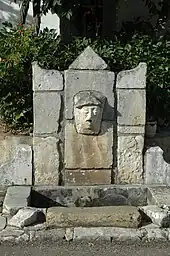
The shutters of a Basque house, made with solid wood slats, are painted the same colour as the other wooden parts of the facades or framing. They are generally in a dark red called "basque red". There has also been, since the 19th century, a very dark blue - a kind of Prussian blue - and a "deep" dark green also as well as sometimes a very light gray. At Arcangues the Marquis, Pierre d'Arcangues, introduced a lighter blue, which has retained the name Blue of Arcangues.
It was in Arcangues that the first Seaska Ikastola was created in 1969.
Languages
According to the Map of the Seven Basque Provinces by Prince Louis-Lucien Bonaparte (1863), the Basque dialect spoken in Arcangues is Northern High Navarrese. However, the classification has changed. With new methodological criteria, the Basque dialectology has grown considerably in recent years and, according to the latest work by the philologist Koldo Zuazo, the Basque dialect used in Arcangues is Navarro-labourdin with an east-west sub-dialect. It is an intermediate sub-dialect combining the Navarro-labourdin sub-dialect of the east and the west.[24]
Until then not to be educated or to be illiterate was not a problem in the Basque Country. The inhabitants had their oral culture and that was enough to satisfy their needs. This lifestyle change radically in the 20th century and French replaced Basque in the general population since literacy was more useful in the dominant language. Then, in the late 1960s, a standard Basque was taught.[25] It in no way replaced the local dialect but had the objective to integrate all formal sectors such as radio, television, print, Internet, research, teaching, literature, administration, etc. In informal areas, however, the dialect is still used, especially in areas where there are native Basque speakers. Despite all these changes it seems that, in the medium term, the navarro-labourdin dialect may disappear with its speakers and be replaced by a unified language: batua.[26]
Civil heritage
- The Chateau of Arcangues
 is registered as an historical monument.[27] It was rebuilt in 1900. The central body of the building, flanked by two wings, is surmounted by a glass roof which illuminates the interior of the building. It stands on a small hill in the middle of a small park planted with oaks.
is registered as an historical monument.[27] It was rebuilt in 1900. The central body of the building, flanked by two wings, is surmounted by a glass roof which illuminates the interior of the building. It stands on a small hill in the middle of a small park planted with oaks.
- The first Chateau of Arcangues seems to have been built[28] in the 12th century and was the seat of the Lordship at the beginning of the village.
- the Chateau of Arcangues, as with Bosquet, was occupied by the Germans during the Second World War;
- the Chateau of Bosquet was rebuilt in 1905 by Jean-Baptiste Ernest Lacombe for André Soulange-Bodin, Minister Plenipotentiary. It is located in the Lanchipiette quarter. Its main facade faces north built in the English style. The south facade is in Basque-Norman style.[11] It opens onto a vast panorama of the Pyrenees and the Bay of Biscay.
- The Villa Berriots, built in 1929, is the work of architect Louis Sue and was built for the couturier Jean Patou. The Estate of the villa (1929)
 is registered as an historical monument.[29]
is registered as an historical monument.[29] - The Theatre of Nature, built in 1968 by the Bayonne architect Cazamayou, faces north below the Town Hall and the fronton. It appears in the form of a huge courtyard with a traditional structure, closed in the west by bay windows. The terraces on the south side are dominated by a huge Fresco by Ramiro Arrue.
- The Fountain in the square depicting the head of a man wearing a beret whose mouth spouts water represents Leon Hegoas, called Brasquette from the house of Brasketa, which the Marquis of Arcangues predicted "that it will do him good to drink water".[11]
- The Marionako Borda House belonging to Luis Mariano, a former singer of international, is located in the commune.
Religious heritage
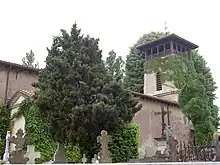
.JPG.webp)
- The Church of Arcangues (12th century) has a Bell Tower (1516)
 which is registered as an historical monument.[30] An inscription above the entrance to the chapel indicates that the Saint-Jean-Baptiste Church of Uhabia was founded in 1516 by Augier d'Arcangues, Squire and Lord.
which is registered as an historical monument.[30] An inscription above the entrance to the chapel indicates that the Saint-Jean-Baptiste Church of Uhabia was founded in 1516 by Augier d'Arcangues, Squire and Lord. - The Cemetery contains an impressive collection of Hilarri, mainly post-16th century, collected by the Marquis Pierre d'Arcangues and combining pieces from three provinces in French Basque country.

 Funerary Stèle
Funerary Stèle Funerary Stèle
Funerary Stèle
Environmental heritage
Part of the territory of the commune belongs to the regional natural reserve of Errota Handia managed by the Academy of Natural Areas of Aquitaine who also manage the Chouroumillas (Xurrumilatx) Pond: a wetland located in the north-west of the commune.
Amenities
- Sports and sports facilities
Other than the Lau-herri Society for Basque pelota, from where the professional champion Simon Haran originated, community life is organized around the Emak-Hor society which has rugby, handball, gymnastics, marching band, a male chorus (Adixkideak) and a folk group. The Golf course between Arcangues and Arbonne has safeguarded the environmental heritage of the town.
- Education
The commune has a primary school.
- Health
There is a pharmacy, a dentist, a GP, and physiotherapists.
Notable people linked to the commune
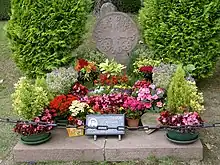
- Rose d'Arcangues (1793-1817), married Casimir d'Angosse, French politician;
- Jean-Baptiste Mariani, who died 18 January 1890 in Rome and was buried on 2 February in Arcangues, was a French diplomat, Minister Plenipotentiary at Munich in 1882, then Ambassador of France to Rome in 1890;[11]
- André Soulange-Bodin (1855-1937), buried in Arcangues, was a French diplomat and politician, Minister Plenipotentiary at Berlin, then Director of Personnel and of the Secretariat of Foreign Affairs in Paris, Mayor of Arcangues from 1919 to 1929. He was the author of two diplomatic works: The diplomacy of Louis XV and the Family Pact (1894) and The Pre-war Germany in Europe (1918). He founded the Association The Basque House in Paris.
- Henry Soulange-Bodin (1885-1965), son of André Soulange-Bodin, he is also buried in Arcangues. He was a man of letters and a French historian specialising in the chateaux of France.
- Luis Mariano, whose real name was Mariano Eusebio González y García, born in Irun in 1914 and died in Paris in 1970, was a Basque-Spanish tenor. He is buried in the Arcangues cemetery which is regularly invaded by his admirers. A bust[11] representing the singer, sculpted by Paul Belmondo is visible in a commune garden. Luis Mariano built Marionako Borda at Arcangues: a Basque house where he made several visits;
- Gustave Pordea, born 3 February 1916 in Dej (Romania), died 12 August 2002 in Arcangues, was a Franco-Romanian diplomat and politician;
- Micaela Cousiño y Quiñones de León, born in 1938 and spent part of her childhood in Arcangues, was the second wife of Henri d'Orléans - "Count of Paris, Duke of France", Orléanist pretender to the throne of France; she was married religiously at Saint John the Baptist Church of Uhabia on 26 September 2009, twenty-five years after her civil marriage;
- Léopold Eyharts, born in 1957, is an astronaut and French Air Force Brigadier. He lived in Arcangues since childhood.
See also
References
- ↑ "Répertoire national des élus: les maires" (in French). data.gouv.fr, Plateforme ouverte des données publiques françaises. 13 September 2022.
- ↑ "Populations légales 2021". The National Institute of Statistics and Economic Studies. 28 December 2023.
- ↑ Google Maps
- ↑ Sandre. "Fiche cours d'eau - Fleuve Uhabia (S50-0400)".
- ↑ Sandre. "Fiche cours d'eau - urdainzko erreka (Q9340500)".
- ↑ Sandre. "Fiche cours d'eau - harrietako erreka (Q9340520)".
- 1 2 3 4 5 6 7 8 9 10 11 Topographic Dictionary of the Department of Basses-Pyrenees, Paul Raymond, Imprimerie nationale, 1863, Digitised from Lyon Public Library 15 June 2011 (in French)
- 1 2 Euskaltzaindia - Academy of the Basque language (Basque)
- 1 2 Jean-Baptiste Orpustan, New Basque Toponymy, Presses universitaires de Bordeaux, 2006, p. 31 ISBN 2 86781 396 4 (in French)
- ↑ E. Goyheneche, Basque Country, Pau, 1979 (in French)
- 1 2 3 4 5 6 7 Arcangues, Under the direction of Hubert Lamant-Duhart, Ekaina, 1986 (in French)
- 1 2 Manuscript from the 14th century in the Departmental Archives of Pyrénées-Atlantiques (in French)
- ↑ Chapter of Bayonne in the Departmental Archives of Pyrénées-Atlantiques (in French)
- ↑ Manuscripts from the 17th and 18th centuries in the Departmental Archives of Pyrénées-Atlantiques (in French)
- ↑ Gascon Registers, Vol. 1, pages 44, 53, 141, 154, 158-159, 195, and 233 - cited by Manex Goyhenetche in his General History of Basque Country, Vol. 3, Elkarlanean, 2001, ISBN 2 9131 5634 7, pages 42 and 43. (in French)
- ↑ Bulletin of the Society of Sciences, Letters and Arts of Bayonne, 1921, No. 3-4, p. 166 and following. (in French)
- ↑ Maison d'Iranda (House of Iranda) (or Irandatz) of Hendaye, cited by Arcangues - under the direction of Hubert Lamant-Duhart, Ekaina, 1986, page 55 (in French)
- ↑ Adventures in the Rifle Brigade, T & W Boone, London, 1867, p. 273
- ↑ List of Mayors of France
- ↑ Pyrénées-Atlantiques, habitants.fr
- ↑ Brigitte Jobbé-Duval, Dictionary of place names - Pyrénées-Atlantiques, 2009, Archives and Culture, ISBN 978-2-35077-151-9 (in French)
- ↑ Des villages de Cassini aux communes d'aujourd'hui: Commune data sheet Arcangues, EHESS (in French).
- ↑ Population en historique depuis 1968, INSEE
- ↑ (in Basque) Atlas of Basque dialects Archived 2008-09-20 at the Wayback Machine published by Koldo Zuazo.
- ↑ The standardisation of the language: The recovery of the Basque language II Archived 2014-02-23 at the Wayback Machine A book from the association Garabide Elkartea based at Durango (Biscay), coordinator: Alberto Barandiaran, Gertu, ISBN 978-84-613-6836-5 (in French).
- ↑ The experience of basque: keys for linguistic recovery and identity Archived 2011-08-17 at the Wayback Machine A book from the association Garabide Elkartea based at Durango (Biscay), coordinator: Lore Agirrezabal Pertusa, Gertu, ISBN 978-84-613-6642-2. The work covers mainly the history of Basque and different actions carried out for its recovery. (in French)
- ↑ Ministry of Culture, Mérimée PA00084312 Chateau of Arcangues (in French)
- ↑ according to Jean de Jaurgain, a Basque historian from the 19th century, cited in Arcangues, Under the direction of Hubert Lamant-Duhart, Ekaina, 1986, page 48 (in French)
- ↑ Ministry of Culture, Mérimée PA64000001 Estate of the Villa Berriotz (in French)
- ↑ Ministry of Culture, Mérimée PA00084313 Bell Tower (in French)

Bibliography
- Arcangues - Under the direction of Hubert Lamant-Duhart - Ekaina 1986
External links
- Touradour travel website on Arcangues
- Arcangues (Arrangoitze) in the Bernardo Estornés Lasa - Auñamendi Encyclopedia (Euskomedia Fundazioa) (in Spanish)
- Arcangues on the 1750 Cassini Map
